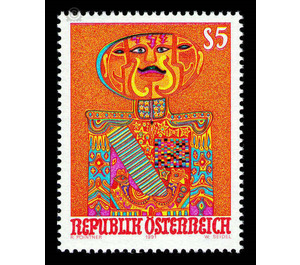Modern Art - Austria / II. Republic of Austria 1991 - 5 Shilling
Theme: Art & Culture
| Country | Austria / II. Republic of Austria |
| Issue Date | 1991 |
| Face Value | 5.00 |
| Color | multi-colored orange |
| Printing Type | combination printing |
| Stamp Type | Commemorative |
| Item Type | Stamp |
| Chronological Issue Number | 1388 |
| Chronological Chapter | OOS-OE2 |
| SID | 873419 |
| In 64 Wishlists | |
Rudolf Pointner was born on 16 March 1907 in Zara (Dalmatia), which at that time belonged to the monarchy, as the son of an official. The changes brought on by the First World War led him and his family to Styria, where the young Pointner was especially fascinated by the peasant world. It was not the documentary image that appealed to him, but the shadowy and ghostly fantasies in the spirit world of the living space. This interest also dominated his artistic work. After settling in Graz, he became a member of the Grazer Sezession and soon turned to surrealism, which corresponded to its fantastic nature. In 1948 he participated in the first surrealist exhibition in Vienna and worked on the "Surrealistic Publications" edited by Max Hölzer. Under his leadership, the group of the Grazer Sezession achieved its greatest artistic charisma in the years 1950-1965.


